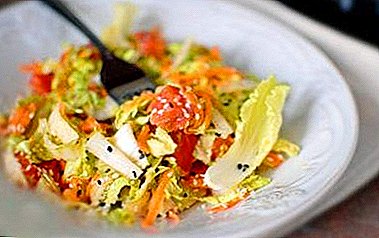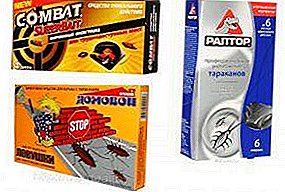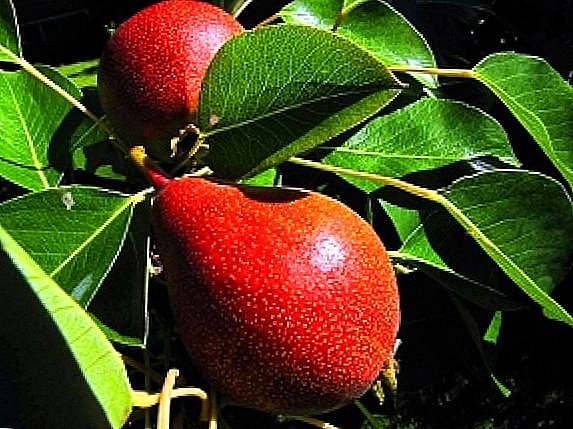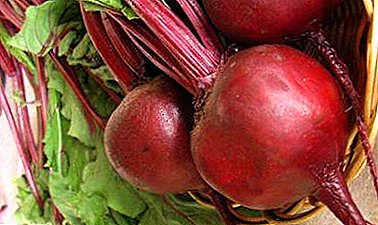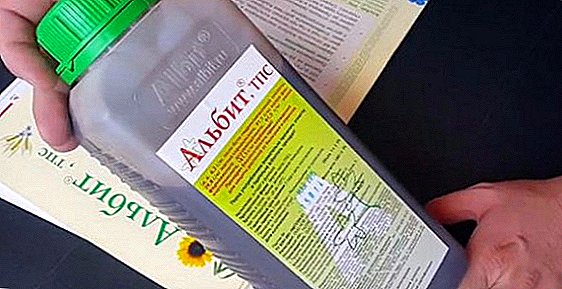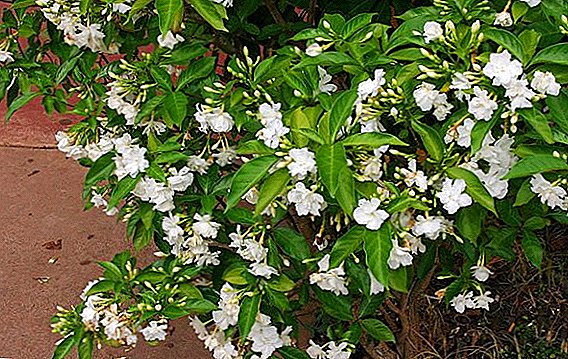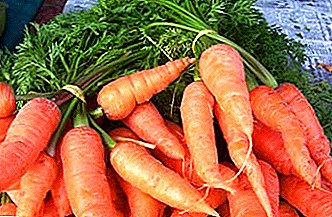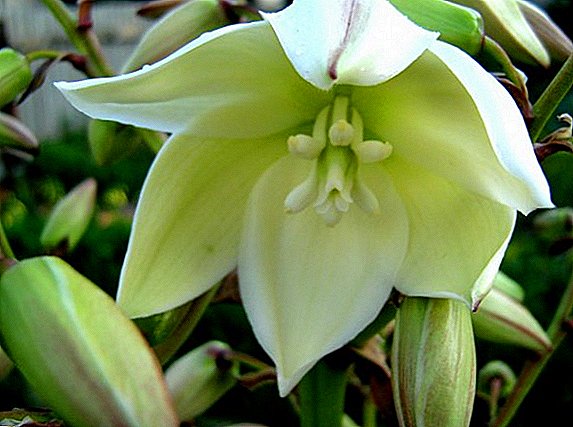 Yucca - This is an evergreen tree belonging to the asparagus family. The stem of a plant is treelike, branched in some species. The leaves are pointed yucca, twisted at the edges. The flowers of the plant are large, white or cream-colored, grouped into a whisk. The fruit has the form of boxes or fleshy berries.
Yucca - This is an evergreen tree belonging to the asparagus family. The stem of a plant is treelike, branched in some species. The leaves are pointed yucca, twisted at the edges. The flowers of the plant are large, white or cream-colored, grouped into a whisk. The fruit has the form of boxes or fleshy berries.
There are about 20 species of yucca. The plant is common in the south of the USA, in Central America, Mexico. And some species have taken root in the south of Europe and are grown under the open sky. It can be eaten, edible yucca. It is a valuable food product, not demanding for growing conditions and gives a good harvest.

From yucca roots you can get flour, they are consumed in baked and boiled form. Heat treatment should be sufficient, it is important.
Yucca has beneficial properties for the human body. It has anti-allergic and anti-inflammatory effects. Yucca contains antioxidants, enzymes, chlorophyll and many other beneficial substances.
Did you know? Yucca can be grown at home. She is considered an unpretentious plant, but she needs a lot of sunlight.
Chemical composition and healing properties of yucca
The chemical composition of yucca following:
- steroid saponins - have antifungal properties, anti-inflammatory and anti-allergic effect, anti-edema effect, reduces the level of cholesterol in the blood;
- enzymes - are involved in the metabolism;
- antioxidants - take part in the metabolism, neutralize harmful substances in the body;
- mucus - have an enveloping effect, a penetrating effect, they are used in gastritis, ulcers, and other diseases of the gastrointestinal tract;
- anthraquinones - have anti-inflammatory, astringent and laxative effects on the body;
- zinc - is involved in the synthesis of proteins, enzymes, fats, increases the absorption of vitamin E in the body, regulates blood sugar levels, strengthens the bone tissue of teeth, supports skin health;
- selenium - has antioxidant properties, improves the absorption of vitamins E, C, protects nucleic acids from damage, is useful for muscles and blood vessels. Improves immunity, helps in the fight against viruses, in conjunction with iodine ensures the normal functioning of the thyroid gland;
- Vitamin A - is involved in the synthesis of enzymes, sex hormones, rhospin in the retina;
- Vitamin C - improves immunity, is involved in the synthesis of collagen, cartilage tissue and has antioxidant properties.

Yucca extract contains zinc and selenium, steroid sapogenins, carbohydrates.
Plant root has many saponins, which stimulates the production of cortisone in the body and is responsible for the anti-inflammatory qualities of the plant. Also in the root contains folic acid, vitamin E, riboflavin, thiamine, niacin, pantothenic acid, vitamin K, calcium, potassium, magnesium, zinc, iron, copper.
Important! In the growing room conditions, yucca blooms extremely rarely. Therefore, when it becomes very warm outside, it needs to be carried to fresh air. For five years of compliance with this condition, the plant will accumulate the necessary substances to bloom.
How to procure and store medical raw materials from yucca
Yucca flower has healing properties, so its different parts are harvested to be used as a raw material for medicines later.
 Yucca Leaves have anti-inflammatory and anti-allergic properties. They must be harvested before and during the flowering of the plant. Cut the leaves laid out a thin layer on the surface, leaving to dry in the sun. Keep them in a well-ventilated area.
Yucca Leaves have anti-inflammatory and anti-allergic properties. They must be harvested before and during the flowering of the plant. Cut the leaves laid out a thin layer on the surface, leaving to dry in the sun. Keep them in a well-ventilated area.
On an industrial scale, yucca harvesting is mechanized. The collected leaves are dried on the currents, stored in well-ventilated areas up to 5 years.
Yucca root It has many useful substances, so it is also harvested. Use for the preparation of drugs need the root of an adult plant. When digging up the roots, it is necessary to remember that they go down to the ground by 50-70 cm. It is necessary to undermine them as deep as possible so that the root system of the yucca is not damaged.
Yucca blooms in the 3rd year of its life. It occurs from the end of June to August. At this time, you can collect the flowers of the plant for preparation of raw materials for drugs. Dried yucca flowers stored in a ventilated area.
Did you know? In order for the yucca to overwinter and survive, when it gets cold, you need to tie its leaves in a bunch. With this technique, the tip will not freeze slightly, and the leaves will not break under the wet snow. The roots of the plant go deep, so they are not afraid of either cold or heat.
The use of yucca in traditional medicine for diseases
 The range of effects of yucca on the body is very wide. This plant is used to treat a large number of diseases: arthritis, gout, polyps in the intestines, prostatitis, flatulence, low blood pressure, etc.
The range of effects of yucca on the body is very wide. This plant is used to treat a large number of diseases: arthritis, gout, polyps in the intestines, prostatitis, flatulence, low blood pressure, etc.
In folk medicine, yucca is used to combat problems such as dry itchy skin, eczema, psoriasis, neurodermatitis, lichen planus. With viral rashes, the juice of yucca leaves is effective.
Important! People suffering from urolithiasis and gallstones, it is contraindicated to take drugs from yucca.
Inflammatory processes
Yucca is useful in inflammatory processes such as arthritis, arthrosis, gout, bursitis. To do this, use the following recipe:
- shredded yucca roots - 1 tablespoon;
- water - 500 ml.
Eczema and psoriasis
For the treatment of psoriasis, eczema and neurodermatitis, yucca must be taken according to the following recipes:
- fresh leaves of yucca-50 grams;
- water - 3-4 liters.

Leaves pour water and bring to a boil. After cooling, the broth is used in the form of lotions to the affected skin..
- Fresh leaves of yucca - 10 grams;
- Baked bacon - 100 grams.
Gastrointestinal tract
Yucca with peptic ulcer has a good effect on the body. For treatment apply leaves of the plant - 10 grams of water is poured over them - 500 ml. The mixture is brought to a boil. This broth should be drunk 3 times a day.
This way you can cure peptic ulcer, gastritis, Crohn's disease, intestinal inflammation.
Diabetes
With the help of yucca is the treatment of diabetes. Drugs that contain extracts of this plant are sold in a pharmacy. You can also cook a decoction of yucca at home.
 For broth yucca with diabetes will need plant root and stem. You can also use flowers, as they contain zinc.
For broth yucca with diabetes will need plant root and stem. You can also use flowers, as they contain zinc.
Raw materials in the amount of 50 grams are poured with 3-4 liters of water, boiled and allowed to cool the broth, and then taken orally.
Prostatitis
To get rid of prostatitis using yucca, you need to cook mixturein which:
- shredded yucca roots;
- burdock;
- Aralia Manchu;
- hydrangea.
The use of yucca in cosmetology
From yucca extracted extract, which has a healing, bactericidal action. Flower plant extract is rich in zinc, selenium, sapogenins, so it is added as an ingredient in some cosmetics for skin and hair care.
How to use yucca in industry
 Yucca is used in the US light industry. Filamentous yucca is grown as a technical plant for the production of strong fibers. These fibers are added to cotton in the production of denim. Thanks to yucca fibers, jeans become more wear-resistant.
Yucca is used in the US light industry. Filamentous yucca is grown as a technical plant for the production of strong fibers. These fibers are added to cotton in the production of denim. Thanks to yucca fibers, jeans become more wear-resistant.
Also, the fibers of this plant are used in the manufacture of ropes for ropes, brushes, fishing gear, burlap and in the manufacture of paper.
Yucca leaves contain steroid sapogenins, due to which the plant is used in the manufacture of hormonal corticosteroid drugs.
There are diseases such as rheumatism, arthritis, and yucca due to the pronounced anti-inflammatory effect is used as a raw material in the latest preparations for the treatment of joints.
Also included in the preparations for the treatment of skin diseases - fungi, juvenile acne and other lesions.
Thus, yucca is used in industrial medicine.
Another industrial application of the plant - natural red dye is extracted from the root.
Contraindications
 Yucca contains substances that break down into simple compounds that can be harmful to humans. One of these compounds is hydrocyanic acid, which, with long-term consumption of yucca in food, can lead to myelopathy, parasthesia.
Yucca contains substances that break down into simple compounds that can be harmful to humans. One of these compounds is hydrocyanic acid, which, with long-term consumption of yucca in food, can lead to myelopathy, parasthesia.
A single use of yucca root in the amount of 400 grams gives a lethal dose of hydrocyanic acid for humans.
Possible side effect of yucca when it is taken and applied:
- nausea;
- vomiting;
- stomach upset;
- diarrhea.
It is contraindicated to take yucca during pregnancy, lactation, in childhood.
Yucca - unpretentious, medicinal and ornamental plant. It can be grown for various purposes and use all the good qualities. But the use of yucca requires moderation so as not to harm health.


